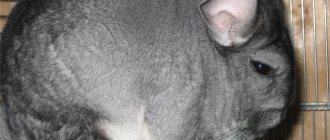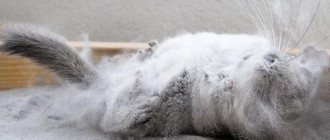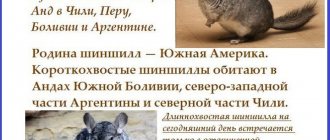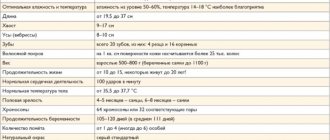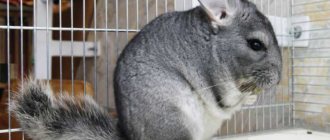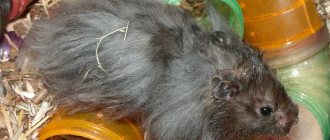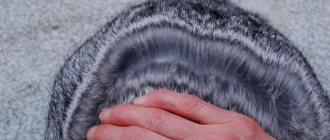Every owner of a chinchilla as a pet should know about the need to periodically bathe the animal. sand for chinchillas is collected in a bath or other container .
sand for chinchillas
Using any liquid for this process may harm your pet's health. This is due to the high density of the fur, which is why it dries slowly. The result is the creation of a favorable environment for pests and even decay, which can lead to the death of the pet.
Types and features of sand composition
You need to know that not every sand is suitable for bathing a chinchilla, since they may have quite large particles that can only harm the animal. Therefore, it is best to use a special one - volcanic. Its main feature is that the particles are more like dust, capable of absorbing excess moisture and do not harm the animal’s fur at all.
Volcanic sand includes:
- Sepiolite. It has a porous structure. It has excellent hydrophilicity and therefore absorbs moisture well.
- Talkomagesite, like sepiolite, is porous, thanks to which it perfectly absorbs moisture and fats, and this is very important for chinchillas.
- Zeolite. It also absorbs moisture. Since it is very dusty, it must be diluted with ordinary sand, but only of a fine fraction.
As we can see, they are all very similar in their properties, so this is the best option for bathing your pet.
Sand for swimming
Sand for bathing chinchillas has little in common with ordinary quartz. Special sand for chinchillas is made from zeolite and sepiolite. Zeolites are frame silicates and have a pronounced pearlescent luster. The main advantage of zeolite is the absorption or release of moisture depending on the level of humidity and temperature in the room. Most often, zeolite sand is used on large chinchilla farms. The remaining mixtures also contain large fractions of ordinary sand to reduce the dustiness of the zeolite. Sepiolite is a fibrous and porous material belonging to the talc group. It is very close in its composition and structure to marine pumice.
You can add medical sulfur powder or the drug Fungistop to the purchased mixture.
This is a good prevention of fungal diseases. It is especially recommended to do this after visiting a veterinarian or an exhibition.
Talc and other additives
To ensure that your pet feels great after bathing and does not contract any fungal diseases, talc or other similar substances should be added to the bathing sand. It will not only protect the chinchilla from parasites, but also prevent the appearance of unpleasant odors. In specialized stores you can find ready-made formulations with all the necessary additives that are necessary for the health of your pet. You can purchase such a set and not rack your brains over this dilemma anymore.
Veterinarians also advise choosing those that contain sulfur and talc. After all, they are the ones who most effectively fight various bacteria and fungal diseases.
The choice of mixtures is truly huge
Why is it needed?
It is considered normal for people and animals to bathe in water, but such unusual animals as chinchillas have taken a more difficult path and prefer to take bathing procedures in volcanic sand in nature. The sand bath becomes a complete replacement for the standard water bath. To keep the fur of these rodents looking clean and well-groomed even at home, you need to bathe them in sand.
One square centimeter of a chinchilla's coat contains about 300 tufts of 80 hairs each, which is why this animal is considered the leader in fur density. Moisture and fat form in the hairs, and skin secretions accumulate in the tufts. Grains of sand, falling on the wool, absorb all the moisture. In addition, when taking a sand bath, chinchillas feel very comfortable; they perceive the procedure as a game.
Classic bathing in water is not suitable for this animal, since dense wool will take a long time to dry out and can provoke putrefactive processes, which can have a detrimental effect on the health of the animal.
In this regard, each owner must take safety measures while walking the pet around the apartment : close all rooms where there may be water (bathroom, toilet), put away buckets and basins with water.
Popular ready-made bath mixtures
There is a huge selection of these mixtures, so many people wonder which one to choose, which one is the best. Let's look at the most popular manufacturing companies that produce this product, study the composition and find out how to use it.
Benelux
This type of sand consists of the smallest zeolite and is produced by a trusted manufacturer. Therefore, the price for it will be slightly higher than for other analog products with similar composition.
Lolopets
This is a budget bath filler. It consists of volcanic dust and crushed quartz. This product has undergone all necessary research and processing.
Mr. Alex
This filler consists of quartz and a sachet of talc, which must be added to the main ingredients immediately before bathing the animal. The main advantage of this product is that it has a very good price, which will be affordable to everyone.
Waka
This bath sand is produced here in Russia. It consists of crushed quartz and volcanic sand. It also comes with a packet of talcum powder. This product has one very significant drawback - it contains large grains that can injure your pet. Therefore, veterinarians advise that before you start bathing, carefully examine it and remove all large particles.
Sand from this company is inexpensive on average and therefore it will be the most affordable for many buyers.
Animals
Another company of Russian origin. Which produces bathing sand. It contains talc, magnesite, and chlorite.
This product also has a fairly affordable price. Most people who have used bath fillers from this company have been very pleased. They say that it does its job perfectly, cleaning the chinchilla's fur without causing any harm to it.
Padovan
This product does a better job of retaining moisture than any of the ones listed above. It consists of crushed zeolite and other minerals that fit the role of a bath filler.
Vitacraft
A very popular product of German origin. It contains a variety of minerals of volcanic origin. For example, such as sepiolite.
Little One
This mixture is one of the most expensive. It contains small grains of minerals of volcanic origin. And since it needs to be changed three times a week, then not every person can afford it. The manufacturer recommends adding about three to five centimeters of sand for the best bathing effect. You can purchase it at any specialized store.
Be sure to check the quality of the sand
Sand baths
For everyday care of the animals' thick and dense fur, sand is enough. It is sand baths that chinchillas take in nature every day. And that's why:
- Sand removes dead skin particles well,
- Frees fur from fallen hairs,
- Cleans from parasites
- Does not cause fur to get wet,
- Does not lead to hypothermia.
When kept at home, a bathing suit with sand is placed in the cage for an hour and a half, at least three times a week.
In large display cages, you can install a permanent bathing suit, but you need to ensure that the fur and skin of the animal do not dry out, and also remove all feces in a timely manner.
How to make sure you make the right choice
You may ask, which one is best to choose, how not to make a mistake in choosing? Let's figure this out and study the basic requirements for high-quality, and most importantly, safe swimming:
- Check the quality of the sand for yourself. To do this, take a small amount of sand in your hand and rub it with your fingers; if during friction you do not feel any discomfort or unpleasant sensations, then this type of filler is ideal for swimming.
- If you place a small amount of the mixture in water, the high-quality product will not immediately sink down, but will float on its surface for some time.
- When drops of water fall on the sand, they are not absorbed, but remain in the form of beads on it.
Sand quality
Even purchased sand needs a quality check before it goes into a chinchilla’s bath. One of the easiest ways to check is to pour a tablespoon of the prepared mixture into a bowl, add a few drops of water and leave for about an hour. A good and high-quality mixture forms lumps that are easy to remove. If, when removed, the lump begins to crumble, it means that it contains a high content of quartz and it is better not to use such sand.
The quality of the mixture can be determined in another way. It requires a small glass in which a tablespoon of sand is placed. After this, water is poured into the glass (about half the volume). A glass of sand and water is left for two to three hours. After the set time, the water is carefully drained. If there is a lot of clay in the mixture, sediment will remain at the bottom. If you transfer this sediment to a sheet of paper and hold it up to the light, you can see inclusions of bright and shiny particles. This is quartz. The more quartz, the worse.
By rubbing the mixture in your palms, you can also check the quality of the sand. A good and high-quality mixture does not scratch or irritate the skin, does not cause discomfort and does not leave a matte shine. However, in this way it is not always possible to determine the exact content of quartz - it may be too fine.
How to make sand for a chinchilla with your own hands
In addition to the fact that bathing sand can be purchased in a store, you can also try to make it yourself with your own hands. You just need to take the following ingredients:
- sand from a quarry, which consists of tiny particles. It can also be found in stores specializing in construction;
- a little talc;
- sulfur.
IMPORTANT! Do not use street sand under any circumstances, because it contains not only large particles and dangerous impurities, but also a huge amount of bacteria, pathogenic fungi, and various infections.
When you have all the necessary ingredients, you can start making the bath mixture. To do this you need:
- sift and wash the sand well;
- after this it needs to be calcined; for this, sand is placed in a frying pan or oven;
- add one or two tablespoons of the remaining components - sulfur and talc - to the heated sand;
- mix well.
Frequently you will have to clean the tray
Features of sand procedures
The best time for swimming is evening. As evening approaches, the rodent is most active, and therefore sand cleaning will be more effective. You can take extra care of your chinchilla's fur if you add medical sulfur, crushed Fungistop or Nystatin to the filler - this is a good fungus prevention.
When a chinchilla bathes, a large amount of dust is generated.
Most likely, during the “bathing” process the room will be filled with dust. This is natural, because the animal spins in the sand, raising the smallest particles into the air. That's why the best place for this type of bathing is the bathroom. Or be prepared to wipe all surfaces in the room with a damp cloth and shake out dust from soft items.
As for sand, it can be reused. But for this it is necessary to remove debris from it. It is also recommended to add fresh material to the old one. The bath should be completely renewed every 10 procedures.
Remember: sand bathing for a chinchilla is as necessary as a comfortable cage and regular food.
Basic questions for beginning breeders
When you first start bathing your pet, you have a huge number of questions, the answers to which you can find on the Internet. Now we will look at the most popular ones that concern most people.
Why does a chinchilla bathe in sand?
And really, why? Everything is quite simple: the climate in the country where the chinchilla comes from is quite dry and hot, there is practically no rain there. Therefore, thanks to evolution, they do not have sebaceous glands, so they are not at all protected from moisture. Consequently, they used volcanic dust for bathing.
How often should you bathe your chinchilla in the sand?
If you don’t touch it too much and it doesn’t get dirty, then it’s enough to bathe the animal 2-3 times a week. But if there is excessive humidity, then, consequently, your pet’s fur coat becomes more dirty, in which case bathing must be done more often - daily. This must be done to prevent infectious diseases from occurring.
Thirty minutes is enough for a chinchilla to take a good bath. Does your chinchilla bathe often?
If your pet is sick, you should avoid bathing. And if he himself refuses to bathe, it means he doesn’t feel well.
ATTENTION ! You should not bathe the animal if there are small wounds on its body, as dirt can get into them and it will get sick.
There's nothing wrong with a chinchilla eating sand.
How to properly wash a chinchilla with water?
Sometimes you have to resort to using water to clean the skin or individual parts of the chinchilla’s body from dirt. For example, if an animal gets its paws dirty while walking around the apartment, you can pour warm water into a bowl and wipe the contaminated areas with a damp swab or sponge.
The water should be such that it is comfortable for a person to hold his hand in it - that is, not too hot or cold. When treating with water, be careful not to wet the rodent's eyes and ears.
After washing, you should immediately wrap your pet in a warm, soft towel. To ensure that the washed chinchilla dries as quickly as possible, it is recommended to use a hair dryer. Put the device on the initial mode (the hair dryer should work quietly) and dry the fur thoroughly. This will protect the animal from hypothermia and colds.
When the fluffy is completely dry, take a comb and gently comb the fur of the animal so that there are no lumps left in it. At this point, the “bath” procedure can be considered complete.
Why does a chinchilla eat sand?
Sometimes while bathing you may notice your pet eating sand, don't worry there is nothing dangerous or suspicious about it. Perhaps he is missing something and is trying to make up for it by eating sand for his bath.
Even veterinarians say that there is nothing wrong with this, and you should not be afraid if you notice that your pet uses sand in its food. There is no need to wean him off this, because sand not only replenishes the balance of microelements, but also normalizes the functioning of all organs, especially those responsible for the digestive system.
Is it possible to use sand from the street to bathe chinchillas?
Of course not. Just think how many harmful substances, bacteria, infections there are. You don't want your chinchilla to get sick and possibly die.
Even after washing and calcining it, you have no guarantee that you will get rid of them all. And, besides this, the grains in it are different, not uniform, and therefore they can lead to injury to your pet.
“Bath” procedures for chinchillas
Like any other animals, chinchillas need regular care. Their fur and body must be kept clean - and not only for the sake of beauty, but also for health. Maintaining hygiene is one of the factors for good health and longevity of a rodent.
Every chinchilla needs a bath
Why does a chinchilla need periodic bathing?
- after cleaning, the animal’s thick fur becomes soft;
- Stuck hairs are removed from the fur coat;
- excess moisture is removed from the body;
- The animal gets tremendous pleasure and relieves stress.
However, you should not indulge in frequent “bath” procedures: daily bathing of chinchillas is prohibited, and it is not necessary.
How to choose
The well-groomed and clean fur of your furry friend largely depends on the quality of the purchased sand, and therefore the choice of this product should be taken with full responsibility. As already mentioned, pure quartz sand is not suitable because the sand grains are too large, so give preference to volcanic varieties that contain sepiolite or zeolite. To determine the quality of sand, as well as to distinguish volcanic products from quartz, carry out simple experiments.
Among manufacturers of bathing sand, the following companies are currently popular, having both their pros and cons.
Mr Alex. The quality is average, since the product is based on quartz. To soften its effects, the kit includes a packet of talcum powder, which must be added to the bath when bathing the animal.
Don’t be afraid of the prices for high-quality sand, as the cost is completely justified. A good product not only effectively cleans your pet’s fur, but is also more economical to use, since it needs to be changed less often than cheap options.


